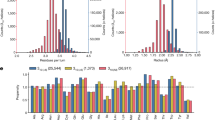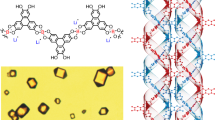Abstract
Synthetic single-helical conformations are quite common, but the formation of double helices based on recognition between the two constituent strands is relatively rare. Known examples include duplex formation through base-pair-specific hydrogen bonding and stacking, as found in nucleic acids and their analogues, and polypeptides composed of amino acids with alternating L and D configurations1,2. Some synthetic polymers3 and self-assembled fibres4 have double-helical winding induced by van der Waals interactions. A third mode of non-covalent interaction, coordination of organic ligands to metal ions5,6,7, can give rise to double, triple and quadruple helices, although in this case the assembly is driven by the coordination geometry of the metal and the structure of the ligands, rather than by direct inter-strand complementarity. Here we describe a family of oligomeric molecules with bent conformations, which exhibit dynamic exchange between single and double molecular helices in solution, through spiral sliding of the synthetic oligomer strands. The bent conformations leading to the helical shape of the molecules result from intramolecular hydrogen bonding within 2′-pyridyl-2-pyridinecarboxamide units8,9,10,11,12, with extensive intermolecular aromatic stacking stabilizing the double-stranded helices that form through dimerization.
This is a preview of subscription content, access via your institution
Access options
Subscribe to this journal
Receive 51 print issues and online access
$199.00 per year
only $3.90 per issue
Buy this article
- Purchase on Springer Link
- Instant access to full article PDF
Prices may be subject to local taxes which are calculated during checkout




Similar content being viewed by others
References
Di Blasio, B., Benedetti, E., Pavone, V. & Pedone, C. Regularly alternating L,D-peptides. The double-stranded right-handed antiparallel β-helix in the structure of t-Boc-(L-Phe-D-Phe)4-OMe. Biopolymers 28, 203–214 (1989).
Langs, D. A. Three-dimensional structure at 0.86 Å of the uncomplexed form of the transmembrane ion channel peptide gramicidin A. Science 241, 188–191 (1988).
Kusanagi, H. X-ray and energy calculation studies on the packing-mode of double-stranded helicies of isotactic poly(methyl methacrylate). Polymer J. 28, 708–711 (1996).
Engelkamp, H., Middelbeek, S. & Nolte, R. J. M. Self-assembly of disk-shaped molecules to coil-coil aggregates with tunable helicity. Science 284, 785–788 (1999).
Koert, M., Harding, M. & Lehn, J. -M. DNH Deoxyribonucleohelicates—self-assembly of oligonucleosidic double-helical metal complexes. Nature 346, 339–342 (1990).
Hasenknopf, B., Lehn, J.-M., Kneisel, B. O., Baum, G. & Fenske, D. Self-assembly of a circular double helicate. Angew. Chem. Int. Edn Engl. 35, 1838–1840 (1996).
Bell, T. W. & Jousselin, H. Self-assembly of a double-helical complex of sodium. Nature 367, 441– 444 (1994).
Redmore, S. M., Rickard, C. E. F., Webb, S. J. & Wright, L. J. Ruthenium complexes of a simple tridentate ligand bearing two ‘distal’ pyridine bases. Inorg. Chem. 36, 4743– 4748 (1997).
Hamuro, Y., Geib, S. J. & Hamilton, A. D. Novel folding patterns in a family of oligoanthranilamides: Non-peptide oligomers that form extended helical secondary structures. J. Am. Chem. Soc. 119, 10587–10593 (1997).
Hamuro, Y., Geib, S. J. & Hamilton, A. D. Novel molecular scaffolds—formation of helical secondary structure in a family of oligoanthranilamides. Angew. Chem. Int. Edn Engl. 33, 446–448 (1994).
Yu, Q. et al. Hydrogen bonded antiparallel beta-strand motifs promoted by 2,6-bis(carbamoylpeptide)pyridine. Chem. Commun. 1467–1468 (1999).
Mazik, M., Bläser, D. & Boese R. Hydrogen-bonding motifs in the crystals of secondary diamides with 2-amino-6-methyl and 2,6-diaminopyridine subunits. Tetrahedron 55, 12771– 12782 (1999).
Bassani, D., Lehn, J.-M., Baum, G. & Fenske, D. Designed self-generation of an extended helical structure from an achiral polyheterocyclic strand. Angew. Chem. Int. Edn Engl. 36, 1845– 1847 (1997).
Ohkita, M., Lehn, J.-M., Baum, G. & Fenske, D. Helicity coding: Programmed molecular self-organization of achiral nonbiological strands into multiturn helical superstructures: synthesis and characterization of alternating pyridine-pyrimidine oligomers. Chem. Eur. J. 5, 3471–3481 (1999).
Cuccia, L. A., Lehn, J.-M., Homo, J.-C. & Schmutz, M. Encoded helical self-organization and self-assembly into helical fibers of an oligoheterocyclic pyridine-pyridazine molecular strand. Angew. Chem. Int. Edn Engl. 37, 233–237 ( 2000).
Nelson, J. C., Saven, J. G., Moore, J. S. & Wolynes, P. G. Solvophobically driven folding of nonbiological oligomers. Science 277, 1793–1796 ( 1997).
Veatch, W. R. & Blout, E. R. The aggregation of gramicidin A in solution. Biochemistry 13, 5257– 5264 (1974).
Sychev, S. V., Barsukov, L. I. & Ivanov, V. T. The double ππ5.6 helix of gramicidin A predominates in unsaturated lipid membranes. Eur. Biophys. J. 22 , 279–288 (1993).
Barsukov, I. L., Arseniev, A. S. & Bystrov, V. F. Spatial structures of gramicidin A in organic solvents. 1H-NMR analysis of four species in ethanol. Bioorg. Khim. 13, 1501–1522 ( 1987).
Berl, V., Krische, M. J., Huc, I., Lehn, J.-M. & Schmutz, M. Template-induced and molecular recognition-directed hierarchical generation of supramolecular assemblies from molecular strands. Chem. Eur. J. 6, 1938– 1946 (2000).
Acknowledgements
We thank J. Fischer and A. DeCian for the use of the X-ray crystallographic facilities at ULP, Strasbourg. This work was supported by the CNRS, by a predoctoral fellowship (V.B.) from the Forschungszentrum Karlsruhe GmbH, Germany, and by a NSF-NATO postdoctoral fellowship (R.G.K.).
Author information
Authors and Affiliations
Corresponding authors
Supplementary information
Supplementary Information
Supplementary Information (PDF 31 kb)
Rights and permissions
About this article
Cite this article
Berl, V., Huc, I., Khoury, R. et al. Interconversion of single and double helices formed from synthetic molecular strands. Nature 407, 720–723 (2000). https://doi.org/10.1038/35037545
Received:
Accepted:
Issue Date:
DOI: https://doi.org/10.1038/35037545
This article is cited by
-
Formation of supramolecular channels by reversible unwinding-rewinding of bis(indole) double helix via ion coordination
Nature Communications (2022)
-
Single crystals of mechanically entwined helical covalent polymers
Nature Chemistry (2021)
-
Double-helical assembly of heterodimeric nanoclusters into supercrystals
Nature (2021)
-
Water-mediated deracemization of a bisporphyrin helicate assisted by diastereoselective encapsulation of chiral guests
Nature Communications (2019)
-
Double helical conformation and extreme rigidity in a rodlike polyelectrolyte
Nature Communications (2019)
Comments
By submitting a comment you agree to abide by our Terms and Community Guidelines. If you find something abusive or that does not comply with our terms or guidelines please flag it as inappropriate.



